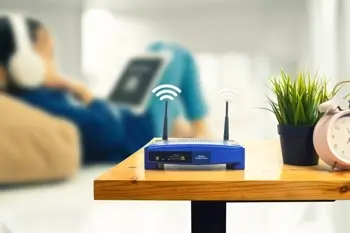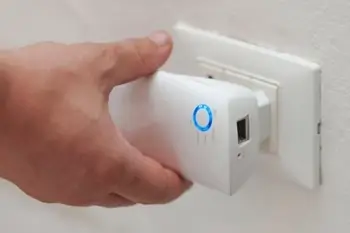WiFi Extender vs. Booster: Learn How to Boost WiFi Signals
WiFi is necessary for most of what we do in our day-to-day lives. We get on the computer, communicate with WiFi calling, stream movies and television shows, and more all across our wireless networks. But WiFi can be troublesome and slow. If you're wondering how to boost WiFi signals in your home or office, there are two devices you can use: a WiFi extender and a WiFi booster. In this article, learn what a Wifi extender vs. booster is, how they work, and how you can boost WiFi signals to get better WiFi.
How does a WiFi booster work?

A WiFi booster doesn't connect to your device directly. Instead, it helps lengthen the reach of your WiFi connection by bridging the gap between two or more host routers. If you have one router that can't broadcast a WiFi signal as far or as strong as you need, getting a second router and a WiFi booster will greatly amplify your WiFi connection.
The WiFi booster takes the signal from the first router and retransmits it to the second router. This extends the reach of your WiFi by having two devices broadcasting instead of one. While two routers can be connected with a direct connection, using a WiFi booster allows for an even wider range of reach, as the two routers can be placed farther apart.
How does a WiFi extender work?
A WiFi range extender is a device that extends your router's range without needing to invest in and connect to a second router. It connects to your existing WiFi network via an app in your computer or phone. It then duplicates the network and rebroadcasts it to give it a farther reach.
You want to place it as far away from your router as you can while still getting a wireless connection to the router. Furthermore, this will give you the widest possible WiFi range.
Because WiFi extenders are simply duplicating the network, they do sometimes run at slightly slower speeds than the original network. If you're considering investing in a WiFi extender to improve your service, look for one on the market that rebroadcasts on the same network name as your original WiFi. Some extenders rebroadcast on a network with a new name, meaning users need to switch networks when they're looking to use the extended WiFi.
Comparing WiFi extenders vs. boosters
Many people find that a WiFi booster or WiFi extender helps to boost their WiFi signal. This will subsequently, strengthen speeds when using computers, phones, game consoles, and other devices connected to the router.
While these two devices serve slightly different purposes, they are both useful in correcting weak or spotty WiFi. It's important to figure out which would work best for you when it comes to choosing between a WiFi booster vs. an extender.
WiFi extenders extend an already existing network, increasing the strength of the signal from the router and allowing the WiFi to reach places that it couldn't before. It doesn't work as an antenna, and it doesn't always provide fast speeds since it's amplifying a different signal. You can think of it as making a recording and replaying it in a different room. The sound can reach farther, in places it previously couldn't, but the sound quality is not as great.
WiFi signal boosters, on the other hand, are used to extend the range of WiFi networks by eliminating dead spots. It will strengthen the signal in places where the WiFi signal is weak. However, rather than creating a new reach for the signal, it can work as an antenna. Because WiFi boosters connect two routers, the signal is stronger and faster than that from a WiFi extender.
How to boost WiFi signals
Everyone experiences slow WiFi at one point or another. If you don't want to invest in a WiFi booster or WiFi extender just yet, try these changes to see if your WiFi connection improves.
Adjust your router location
Where you place your router has a surprisingly big impact on its performance. Walls can hinder a WiFi signal, especially in large homes or offices. If you're wondering how to boost WiFi signals through walls, the best and simplest answer is this: move the router to a more open, central location.
Moving your router to a more open access point can allow the wireless transmissions to go farther faster. Focus on getting it as close as possible to devices that need more bandwidth, like laptops and consoles, and away from devices that emit other electromagnetic waves, like microwaves.
You could have your computer or printer in a dead zone; moving the router to an open space creates a stronger signal strength and improves the way the WiFi router's signal can travel through walls and levels.
Switch channels
WiFi signals are divided into channels, used to communicate with devices on a network. Your router uses a certain channel, but if there are others nearby with routers using the same WiFi channels, it causes issues like slower speeds. Try switching WiFi channels to solve the problem. Because each router handles this differently, you’ll need to check for your router’s instructions online or in device settings.
Typically, routers broadcast at two main frequencies: 2.4 GHz and 5 GHz. The 5-GHz provides faster connection, but a shorter range. The 2.4-GHz gives a slightly slower connection, but a wider range. Leaving both frequencies enabled on a dual-band router allows all devices to work on your router and gives your WiFi the best chance to boost the signal of WiFi in your home.
Try an Ethernet cable
Though it’s not the most advanced WiFi option, using an Ethernet cable gives you a faster and more stable connection. The wired connection means that you’re more limited in where you can place your devices—they’ll have to be able to plug into the cable as a wired device.
But for devices that need the fastest possible Internet, connecting to the Ethernet port is a great option. Likewise, if you’re in a meeting or live streaming and want to ensure that your WiFi doesn’t cut out, an Ethernet cable offers connection security.
Remove unused devices
It’s helpful to disconnect any devices on your WiFi that don’t require connection at that moment in time. Having too many devices attempting to use your WiFi all at once can cause Internet speed issues. Often, high-quality routers will have the option to prioritize certain devices over others. Consider investing in one if you find removing your devices on your own too tedious.

If you'd rather do it manually, the process is simple. Just log in to your router and enter your admin username and password, then clear out any old devices still connected to the WiFi.
You can get to your router's login by typing the network's IP address into the address bar, which is likely one of four: 192.168.0.1, 192.168.1.1, 192.168.1.254 or 10.0.0.1.
How to boost WiFi signal on phone
Boosting the WiFi signal to your phone requires a similar process. If you find that your phone isn't connecting to WiFi or that you just have a weak signal, moving the router to a different location is a good first step.
Figure out where the strongest signal comes from in your house and go to that area if you need to perform a download or access the Internet. Changing the WiFi channel can also help, and removing unused devices will allow a stronger WiFi signal to reach your phone.
However, there are also phone-specific steps to take to try and improve your WiFi signal. Check and see if your case has any metal in it. Even if it doesn't, in some instances, phone cases can interfere with WiFi signals and even block them from reaching the device. Take your case off and see if your connection is any better.
You can also assign priority to your phone on your WiFi router. Log in to your router on a web browser and change your settings to prioritize your phone over other devices, like a computer or television, when it comes to providing a strong WiFi signal.
Finally, if all else fails, try a different network. Use a WiFi analyzer app to locate the best WiFi network to use near you; it may not be the one you're already connected to.
Top three best WiFi extenders to boost WiFi signals
Though users have many options when it comes to picking a good WiFi extender, according to CNet, these are the best WiFi extenders to invest your money in.
TP-Link RE605X
This range extender is fairly affordable ($100) considering all the features that it includes. It has full WiFi 6 support, adjustable antennae, and an easy-to-use app for control. It provides great coverage. While it initially creates a separate network, which is slightly annoying to deal with.
You can easily use the app to sync the networks together. This allows you to seamlessly use the Internet no matter where in your home you go.
Linksys RE7310
This router has a similar price point as the TP-Link and incredibly fast speeds throughout the whole home. It works well with WiFi 6, though doesn't perform quite as well with WiFi 5 devices. The Linksys extender is a great choice for anyone looking to extend their WiFi's range.
D-Link EaglePro AI
For those looking to save some money, the D-Link router is a great choice. Its price point of $65 makes it a little more budget-friendly, and it still has great WiFi 6 support. It has quick download speeds and average upload speeds, and works best in smaller homes.
How to troubleshoot WiFi
Now, more devices than ever are WiFi-enabled, from printers to cameras and even refrigerators. While the wireless access adds a lot of features to these devices, it also means we’re more dependent on WiFi, which makes it harder when the WiFi isn’t working.

You can't solve all WiFi connection issues independently. You might need to call your Internet service provider or even get a new wireless router. However, if you’re having issues with your WiFi, there are some quick fixes you can try yourself at home. Try these quick fixes before taking bigger, more time-consuming steps.
- Restart your router or device. Restarting your router is fairly simple: unplug the router and wait sixty seconds, then plug it back in. Restart your device by turning it off and on again. If the problem is a temporary error with the wireless signals on either side, this can solve the issue.
- Hardwire your computer. Try plugging your computer directly into your router with an Ethernet cable. This is to determine whether it’s a WiFi or Internet issue. Additionally, if the Ethernet cable works, you can use it in a pinch until a permanent fix can happen.
- Check that your equipment functions correctly. Take a look at the lights on your router to make sure they’re properly lit and everything is functioning correctly. The lights can indicate where the router’s experiencing an error.
If that is the case, you have the option to perform a factory reset by pressing the small reset button on the back of the router. Press and hold the button for a few seconds until your router's lights blink. If you do this, make sure to set up any previous connection settings again - such as port forwarding - as these will be erased.
Using public WiFi safely
Because of the way WiFi works across airwaves, using public WiFi can be risky as it makes your devices vulnerable to personal information theft. It also creates a potential target for cybercriminals or hackers.
Don’t give a free WiFi network any personal information. Because the networks aren’t secured, your information is more likely to be stolen.
Similarly, don’t allow file sharing over public or open networks. Often, people go to coffee shops or libraries with public WiFi in order to do work. If you allow file sharing, you could open yourself up to have sensitive work documents compromised. Even if you’re not working on something important, it’s best to keep your documents safe.
Furthermore, stick to HTTPS sites for maximum security. These sites are encrypted. That means the data that travels between your device and the website’s server can’t be taken over by hackers.